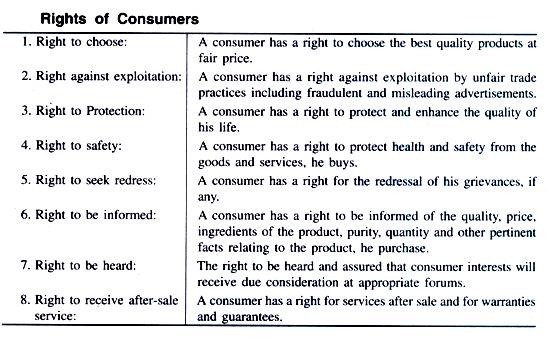consumerism and waste products
Evolution of Consumerism:
The idea of ‘consumerism’ was first conceived in USA around the beginning of this century.
Its evolution can be studied in three distinct phases as follows:
1. Around 1900:
The business firms dealing in meat packing were least concerned with the consumers. Meat used to be sold in the most unhealthy manner. This affected the health of the consumers. Even many other firms used to produce dangerous, unwanted products and drugs and sell them to the consumers by adopting manipulative devices. Conscious and sensible became disgusted with this sort of affairs and started campaign to preserve the interests of the consuming public.
2. Around 1930:
Consumerism assumed more importance because people in general became more enlightened and concerned with the standards of good quality products. This was possible on account of education, awareness and political consciousness. Although consumerism did not become a serious public movement during this time, the Government came up with a legislation called Miller-Tiching Act 1936 in order to regulate certain marketing mal-practices.
3. 1960’s:
It is in the sixties of this century consumerism became a very forceful social movement. Late President Kennedy, in the year 1962, passed a legislation to protect the consumers’ rights particularly with regard to false advertising and unhealthy packaging of food and other articles. The consumerism movement reached its height when a serious criticism was levelled against the ‘un-safety’ of automobile companies which caused death to many people.
Unique Problems of Indian Consumers:
Indian consumers face several unique problems requiring more involvement and support from the Government and the Consumer Organisations to protect their rights.
Some are given below:
1. Consumerism is still in its infancy and not well organised. Majority of Indian consumers are not consciously aware of their rights.
2. Shortage of essential commodities occur very often in India. Such imbalances lead to hoarding and black-marketing, profiteering and corruptions.
3. Many consumers are ignorant and uneducated and in such situations, the marketer exploit the consumer. There are many such cases in India.
4. Producers advertise their products, not with a view to serve the public, but with a view to dispose of their dead products at a good profit.
5. Consumers become easy victims, in the absence of information, and buy sub-standard and defective products.
6. The court procedure in India is a time consuming and tiresome process. Thus, consumers avoid legal actions. People are unaware of the simple procedures under the Consumer Protection Act.
7. Supplier, and not the consumer, becomes the king in the market.
Consumer Orientation:
We know that the consumer orientation has been given maximum importance by the marketers. Satisfaction and well being of the consumer should be the objective of all business units. In real practice, he is not protected or safeguarded but, he is cheated and looted.
Consumer Protection Act 1986:


